Abstract
Lysosome-disrupting enzyme substrates have been used to distinguish between lysosomal and prelysosomal compartments along the endocytic pathway in isolated rat hepatocytes. The cells were incubated for various periods of time with 125I-labelled tyramine cellobiose (125I-TC) covalently coupled to asialoorosomucoid (AOM) (125I-TC-AOM); this molecule is internalized by receptor-mediated endocytosis and degraded in lysosomes, where the degradation products (acid-soluble, radio-labelled short peptides) accumulate, Glycyl-L-phenylalanine 2-naphthylamide (GPN) and methionine O-methyl ester (MOM), which are hydrolysed by lysosomal cathepsin C and a lysosomal esterase respectively, both diffused into hepatocytic lysosomes after electrodisruption of the cells. Intralysosomal accumulation of the hydrolysis products (amino acids) of these substrates caused osmotic lysis of more than 90% of the lysosomes, as measured by the release of acid-soluble radioactivity derived from 125I-TC-AOM degradation. The acid-soluble radioactivity coincided in sucrose-density gradients with a major peak of the lysosomal marker enzyme acid phosphatase at 1.18 g/ml; in addition a minor, presumably endosomal, acid phosphatase peak was observed around 1.14 g/ml. The major peak of acid phosphatase was almost completely released by GPN (and by MOM), while the minor peak seemed unaffected by GPN. Acid-insoluble radioactivity, presumably in endosomes, banded (after 1 h of 125I-TC-AOM uptake) as a major peak at 1.14 and a minor peak at 1.18 g/ml in sucrose gradients, and was not significantly released by GPN. GPN thus appears to be an excellent tool by which to distinguish between endosomes and lysosomes. MOM, on the other hand, released some radioactivity and acid phosphatase from endosomes as well as from lysosomes.
Full text
PDF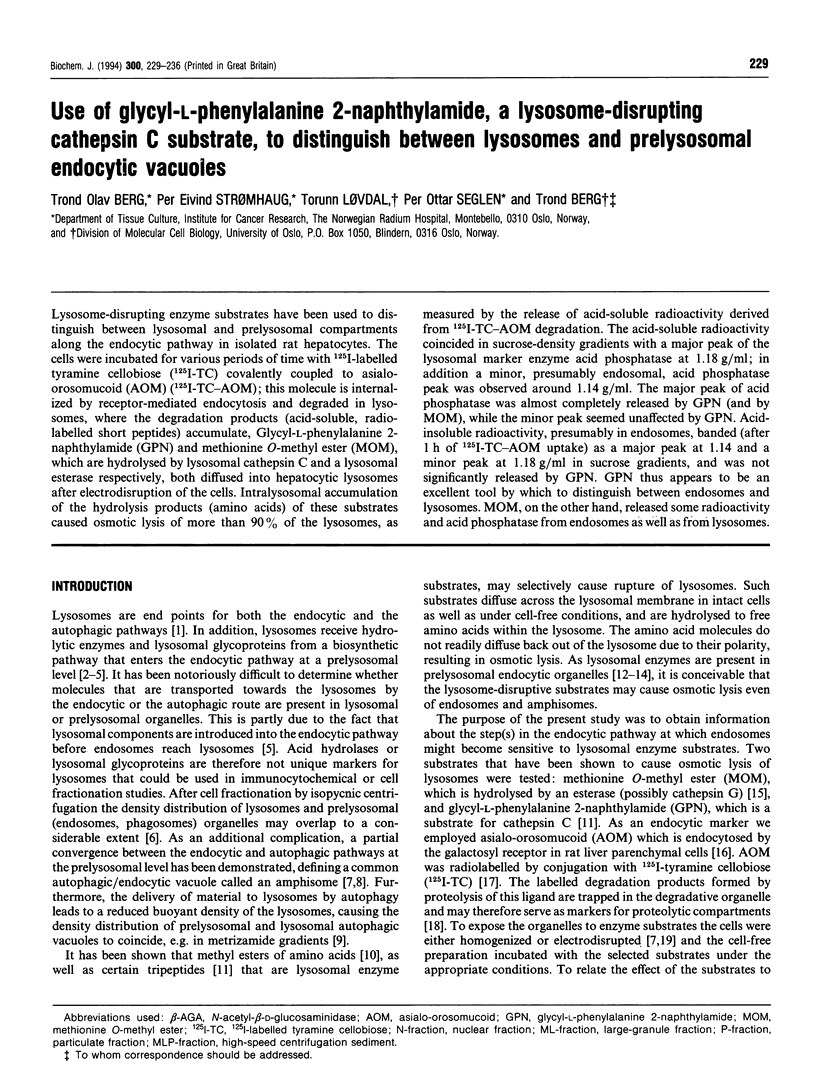
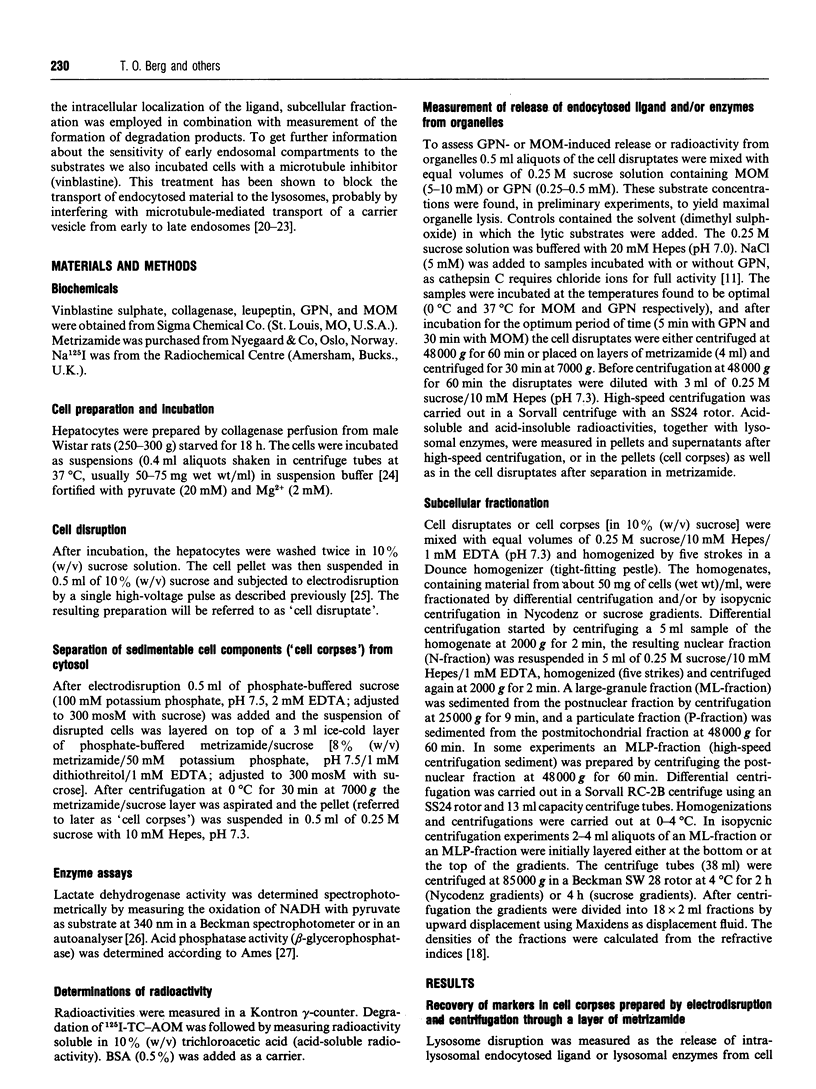
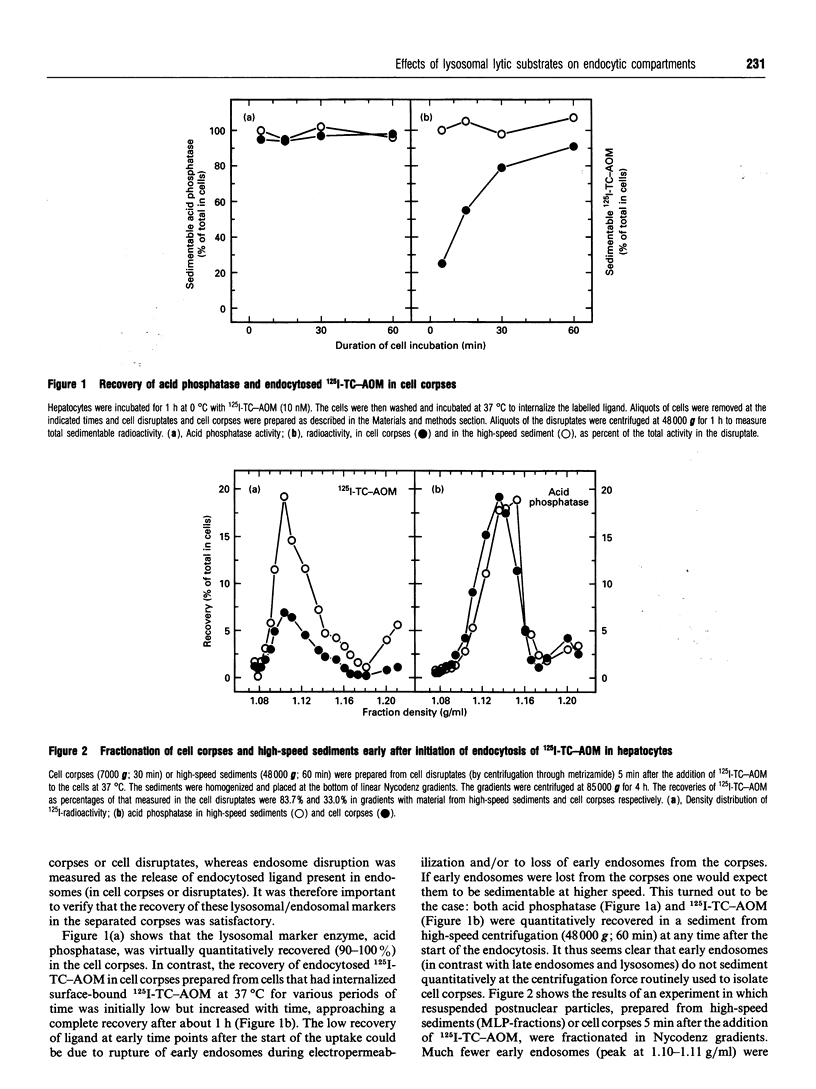
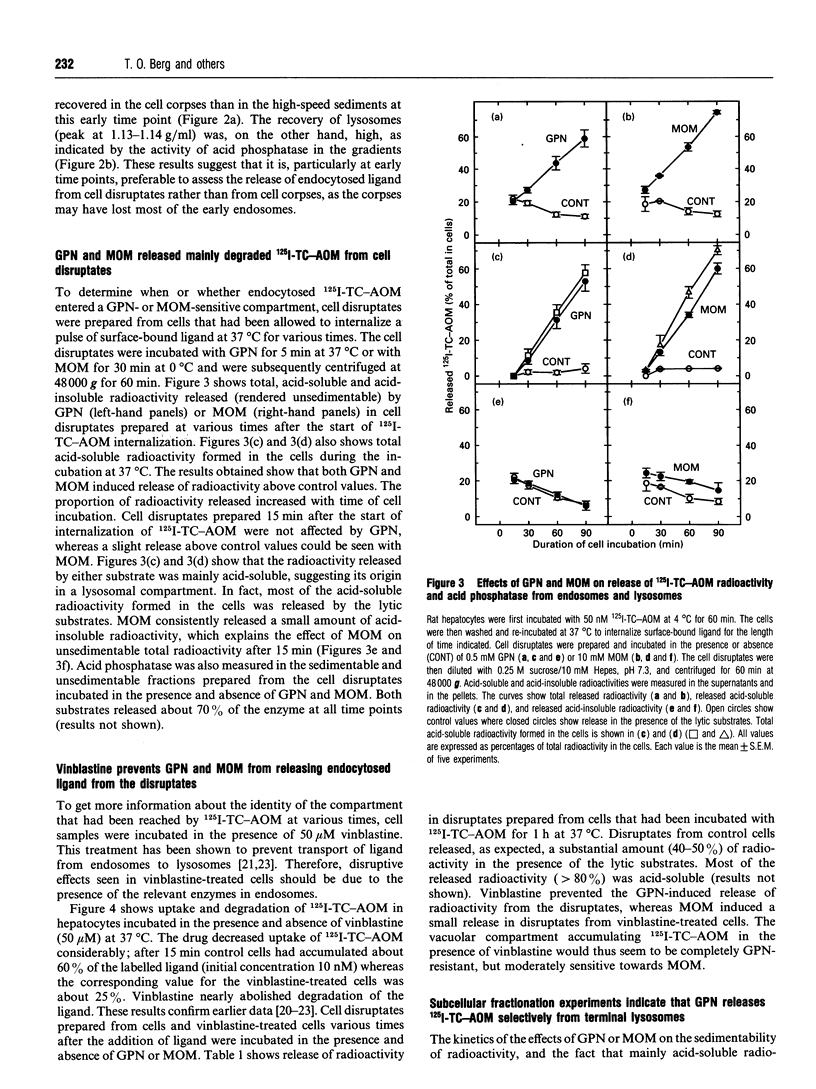
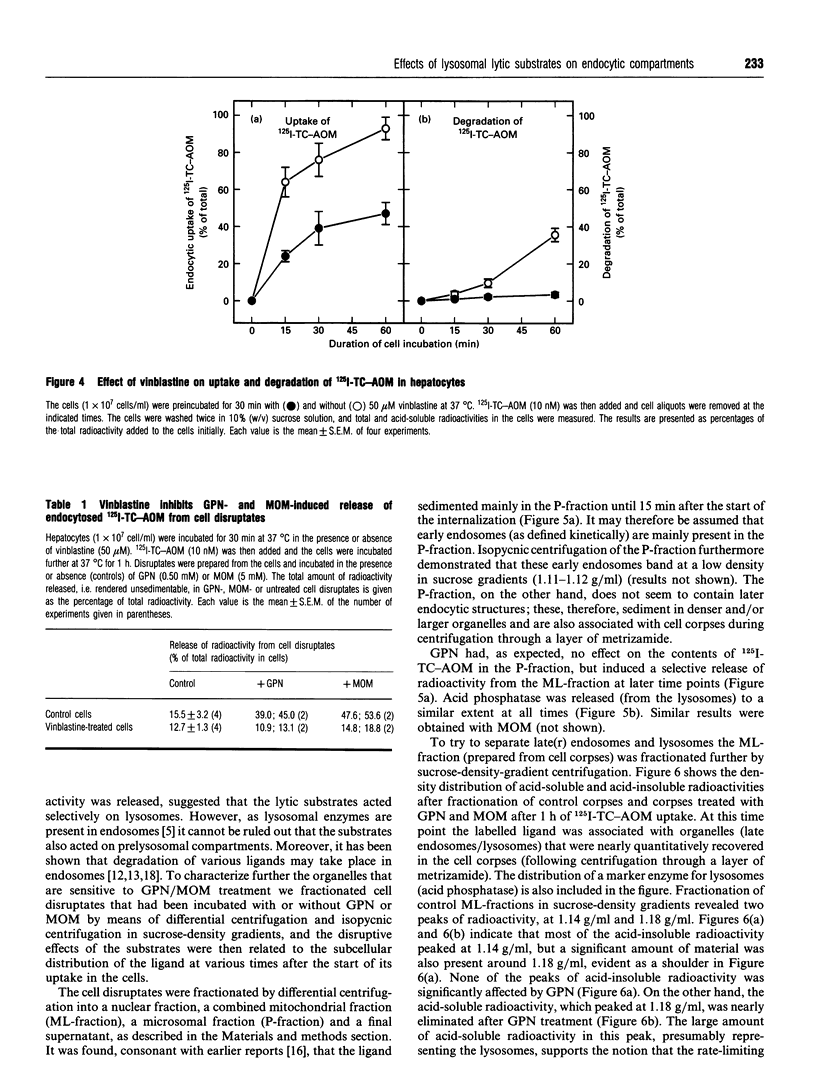
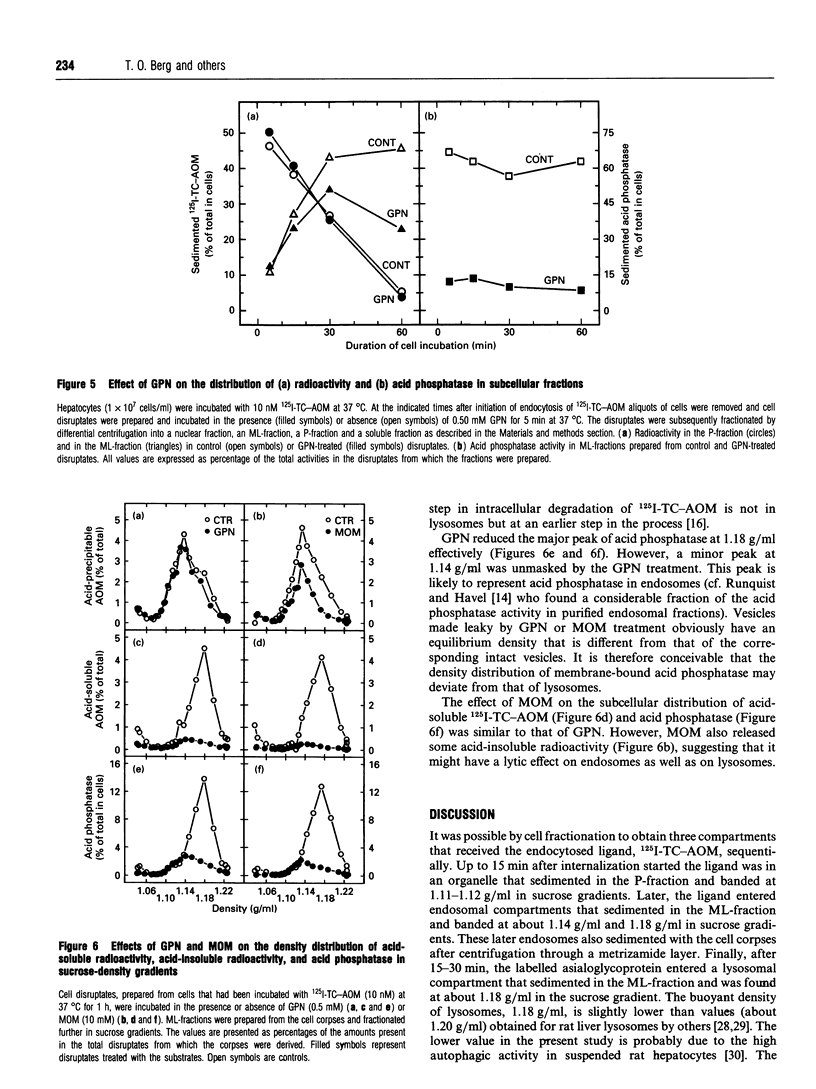
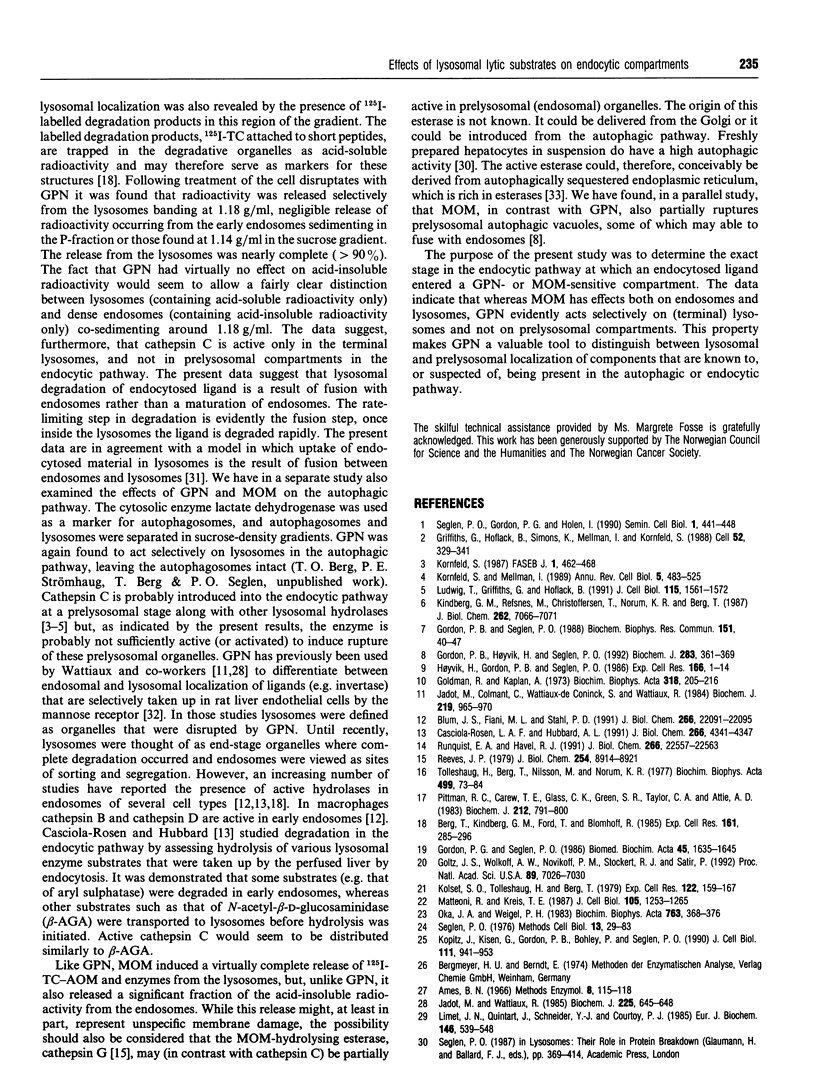

Selected References
These references are in PubMed. This may not be the complete list of references from this article.
- Amar-Costesec A., Beaufay H., Wibo M., Thinès-Sempoux D., Feytmans E., Robbi M., Berthet J. Analytical study of microsomes and isolated subcellular membranes from rat liver. II. Preparation and composition of the microsomal fraction. J Cell Biol. 1974 Apr;61(1):201–212. doi: 10.1083/jcb.61.1.201. [DOI] [PMC free article] [PubMed] [Google Scholar]
- Berg T., Kindberg G. M., Ford T., Blomhoff R. Intracellular transport of asialoglycoproteins in rat hepatocytes. Evidence for two subpopulations of lysosomes. Exp Cell Res. 1985 Dec;161(2):285–296. doi: 10.1016/0014-4827(85)90086-2. [DOI] [PubMed] [Google Scholar]
- Blum J. S., Fiani M. L., Stahl P. D. Proteolytic cleavage of ricin A chain in endosomal vesicles. Evidence for the action of endosomal proteases at both neutral and acidic pH. J Biol Chem. 1991 Nov 25;266(33):22091–22095. [PubMed] [Google Scholar]
- Casciola-Rosen L. A., Hubbard A. L. Hydrolases in intracellular compartments of rat liver cells. Evidence for selective activation and/or delivery. J Biol Chem. 1991 Mar 5;266(7):4341–4347. [PubMed] [Google Scholar]
- Goldman R., Kaplan A. Rupture of rat liver lysosomes mediated by L-amino acid esters. Biochim Biophys Acta. 1973 Aug 22;318(2):205–216. doi: 10.1016/0005-2736(73)90114-4. [DOI] [PubMed] [Google Scholar]
- Goltz J. S., Wolkoff A. W., Novikoff P. M., Stockert R. J., Satir P. A role for microtubules in sorting endocytic vesicles in rat hepatocytes. Proc Natl Acad Sci U S A. 1992 Aug 1;89(15):7026–7030. doi: 10.1073/pnas.89.15.7026. [DOI] [PMC free article] [PubMed] [Google Scholar]
- Gordon P. B., Høyvik H., Seglen P. O. Prelysosomal and lysosomal connections between autophagy and endocytosis. Biochem J. 1992 Apr 15;283(Pt 2):361–369. doi: 10.1042/bj2830361. [DOI] [PMC free article] [PubMed] [Google Scholar]
- Gordon P. B., Seglen P. O. Prelysosomal convergence of autophagic and endocytic pathways. Biochem Biophys Res Commun. 1988 Feb 29;151(1):40–47. doi: 10.1016/0006-291x(88)90556-6. [DOI] [PubMed] [Google Scholar]
- Gordon P. B., Seglen P. O. Use of electrical methods in the study of hepatocytic autophagy. Biomed Biochim Acta. 1986;45(11-12):1635–1645. [PubMed] [Google Scholar]
- Griffiths G., Hoflack B., Simons K., Mellman I., Kornfeld S. The mannose 6-phosphate receptor and the biogenesis of lysosomes. Cell. 1988 Feb 12;52(3):329–341. doi: 10.1016/s0092-8674(88)80026-6. [DOI] [PubMed] [Google Scholar]
- Høyvik H., Gordon P. B., Seglen P. O. Use of a hydrolysable probe, [14C]lactose, to distinguish between pre-lysosomal and lysosomal steps in the autophagic pathway. Exp Cell Res. 1986 Sep;166(1):1–14. doi: 10.1016/0014-4827(86)90503-3. [DOI] [PubMed] [Google Scholar]
- Jadot M., Colmant C., Wattiaux-De Coninck S., Wattiaux R. Intralysosomal hydrolysis of glycyl-L-phenylalanine 2-naphthylamide. Biochem J. 1984 May 1;219(3):965–970. doi: 10.1042/bj2190965. [DOI] [PMC free article] [PubMed] [Google Scholar]
- Jadot M., Wattiaux R. Effect of glycyl-L-phenylalanine 2-naphthylamide on invertase endocytosed by rat liver. Biochem J. 1985 Feb 1;225(3):645–648. doi: 10.1042/bj2250645. [DOI] [PMC free article] [PubMed] [Google Scholar]
- Kindberg G. M., Refsnes M., Christoffersen T., Norum K. R., Berg T. The relationship between autophagy and the intracellular degradation of asialoglycoproteins in cultured rat hepatocytes. J Biol Chem. 1987 May 25;262(15):7066–7071. [PubMed] [Google Scholar]
- Kolset S. O., Tolleshaug H., Berg T. The effects of colchicine and cytochalasin B on uptake and degradation of asialo-glycoproteins in isolated rat hepatocytes. Exp Cell Res. 1979 Aug;122(1):159–167. doi: 10.1016/0014-4827(79)90570-6. [DOI] [PubMed] [Google Scholar]
- Kopitz J., Kisen G. O., Gordon P. B., Bohley P., Seglen P. O. Nonselective autophagy of cytosolic enzymes by isolated rat hepatocytes. J Cell Biol. 1990 Sep;111(3):941–953. doi: 10.1083/jcb.111.3.941. [DOI] [PMC free article] [PubMed] [Google Scholar]
- Kornfeld S., Mellman I. The biogenesis of lysosomes. Annu Rev Cell Biol. 1989;5:483–525. doi: 10.1146/annurev.cb.05.110189.002411. [DOI] [PubMed] [Google Scholar]
- Kornfeld S. Trafficking of lysosomal enzymes. FASEB J. 1987 Dec;1(6):462–468. doi: 10.1096/fasebj.1.6.3315809. [DOI] [PubMed] [Google Scholar]
- Limet J. N., Quintart J., Schneider Y. J., Courtoy P. J. Receptor-mediated endocytosis of polymeric IgA and galactosylated serum albumin in rat liver. Evidence for intracellular ligand sorting and identification of distinct endosomal compartments. Eur J Biochem. 1985 Feb 1;146(3):539–548. doi: 10.1111/j.1432-1033.1985.tb08685.x. [DOI] [PubMed] [Google Scholar]
- Ludwig T., Griffiths G., Hoflack B. Distribution of newly synthesized lysosomal enzymes in the endocytic pathway of normal rat kidney cells. J Cell Biol. 1991 Dec;115(6):1561–1572. doi: 10.1083/jcb.115.6.1561. [DOI] [PMC free article] [PubMed] [Google Scholar]
- Magnusson S., Berg T. Extremely rapid endocytosis mediated by the mannose receptor of sinusoidal endothelial rat liver cells. Biochem J. 1989 Feb 1;257(3):651–656. doi: 10.1042/bj2570651. [DOI] [PMC free article] [PubMed] [Google Scholar]
- Matteoni R., Kreis T. E. Translocation and clustering of endosomes and lysosomes depends on microtubules. J Cell Biol. 1987 Sep;105(3):1253–1265. doi: 10.1083/jcb.105.3.1253. [DOI] [PMC free article] [PubMed] [Google Scholar]
- Oka J. A., Weigel P. H. Microtubule-depolymerizing agents inhibit asialo-orosomucoid delivery to lysosomes but not its endocytosis or degradation in isolated rat hepatocytes. Biochim Biophys Acta. 1983 Dec 19;763(4):368–376. doi: 10.1016/0167-4889(83)90098-8. [DOI] [PubMed] [Google Scholar]
- Pittman R. C., Carew T. E., Glass C. K., Green S. R., Taylor C. A., Jr, Attie A. D. A radioiodinated, intracellularly trapped ligand for determining the sites of plasma protein degradation in vivo. Biochem J. 1983 Jun 15;212(3):791–800. doi: 10.1042/bj2120791. [DOI] [PMC free article] [PubMed] [Google Scholar]
- Reeves J. P. Accumulation of amino acids by lysosomes incubated with amino acid methyl esters. J Biol Chem. 1979 Sep 25;254(18):8914–8921. [PubMed] [Google Scholar]
- Runquist E. A., Havel R. J. Acid hydrolases in early and late endosome fractions from rat liver. J Biol Chem. 1991 Nov 25;266(33):22557–22563. [PubMed] [Google Scholar]
- Seglen P. O., Gordon P. B., Holen I. Non-selective autophagy. Semin Cell Biol. 1990 Dec;1(6):441–448. [PubMed] [Google Scholar]
- Seglen P. O. Preparation of isolated rat liver cells. Methods Cell Biol. 1976;13:29–83. doi: 10.1016/s0091-679x(08)61797-5. [DOI] [PubMed] [Google Scholar]
- Tolleshaug H., Berg T., Nilsson M., Norum K. R. Uptake and degradation of 125I-labelled asialo-fetuin by isolated rat hepatocytes. Biochim Biophys Acta. 1977 Aug 25;499(1):73–84. doi: 10.1016/0304-4165(77)90230-6. [DOI] [PubMed] [Google Scholar]


